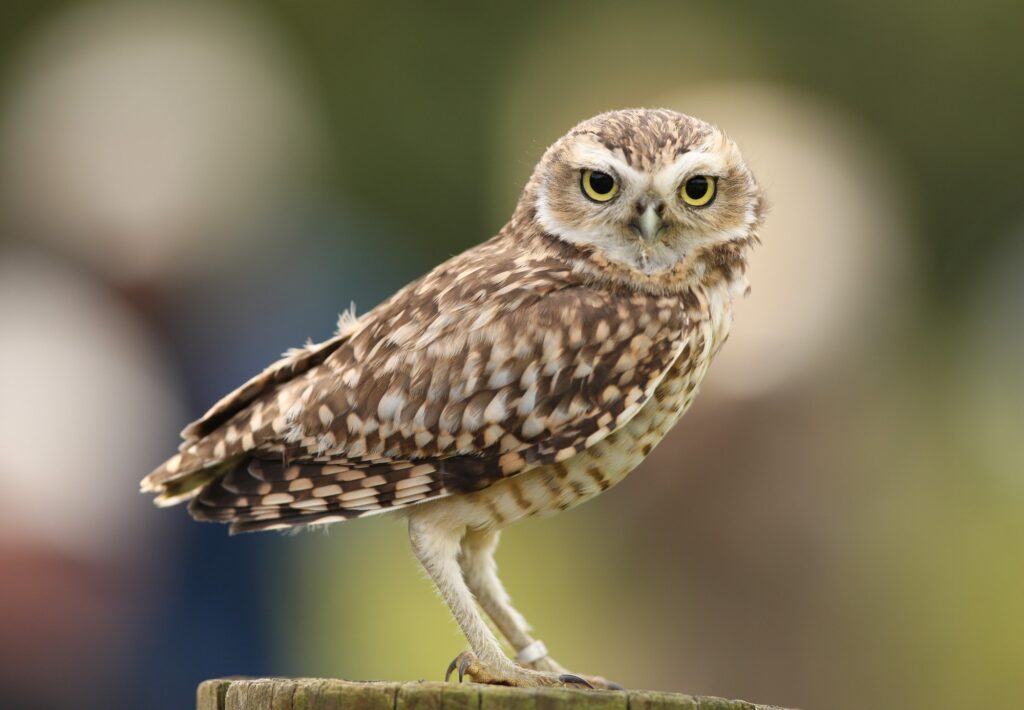The state’s unique southwest location plus its varied geography make the wildlife in Arizona as rich and diverse as you can imagine. The most noteworthy places in the state you’ll want to visit are the Grand Canyon, Flagstaff, and Saguaro National Park.
Arizona is home to a wide variety of birds — about 551 bird species, with 451 types of birds achieving year-round status and the rest being migratory or occasional visitors. There are 12 different types of owls you can find in the wilderness, plus the famous barn owl.
A Little More About Owls
Owls are silent killers and magnificent, often nocturnal predators that were carefully designed for hunting. These nocturnal birds of prey follow their targets in very low light without making a sound, and they do all this while flying at impossibly low heights.
They’re equipped with front-facing binocular eyes, well-developed ears, special wings for silent flight, fully-rotating necks, and cryptic feathers – not to mention their sharp claws and powerful beaks!
These beautiful birds can be as large as eagles or as small as robins, and there are interesting variations of their general features. Several of these birds wouldn’t be hard to spot and identify at all…but we’ll discuss that more below.
Now, without further delay, let’s meet the first owl in Arizona!
Barn Owl

- Scientific Name: Tyto alba
- Length: 12.6-15.8 inches
- Weight: 14.1-24.7 ounces
- Wingspan: 39.4-49.2 inches
Of the approximately 46 variations of barn owls, the smallest lives in the Galapagos and the biggest bird in the owl family is the one found in North America. These birds are highly adaptive, and they can take residence on tree branches, in tree cavities, in the middle of farm plantations, inside buildings, and even in a stadium!
Barn owls, characterized mainly by their heart-shaped faces, tend to feed on the rodents around them. And, in typical owl fashion, this bird eats its food whole, then spits out the carcass and fur as a pellet.
Flammulated Owl
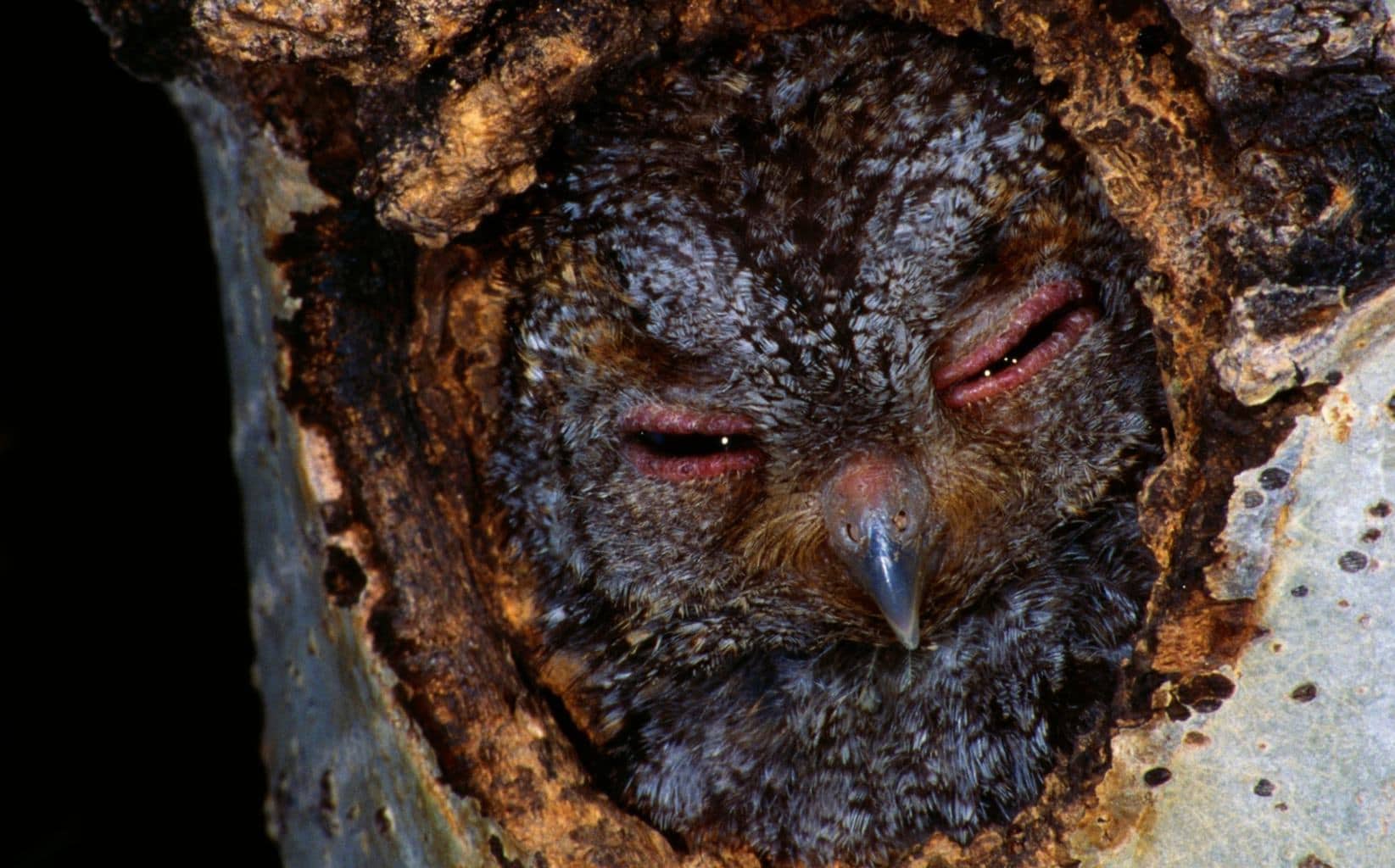
- Scientific Name: Psiloscops flammeolus
- Length: 5.9-6.7 inches
- Weight: 1.5-2.2 ounces
- Wingspan: 15.9-16.1 inches
These tiny-sized owls are masters of camouflage, and this skill includes imitating the common sounds of much larger birds, thanks to their extra-wide windpipes. They also like to make hiding places among treetops in mature coniferous forests and at high elevations.
To make following them even more difficult, the flammulated owl doesn’t chase after small mammals, but rather, settles for insects as its main course. Therefore, the bird doesn’t need to engage in elaborate raids of fly too far away from its nest to hunt prey.
Flammulated owls are quite similar to northern pygmy-owls and whiskered screech owls, but their hoots are your best bet in differentiating between the birds of prey.
Whiskered Screech-Owl
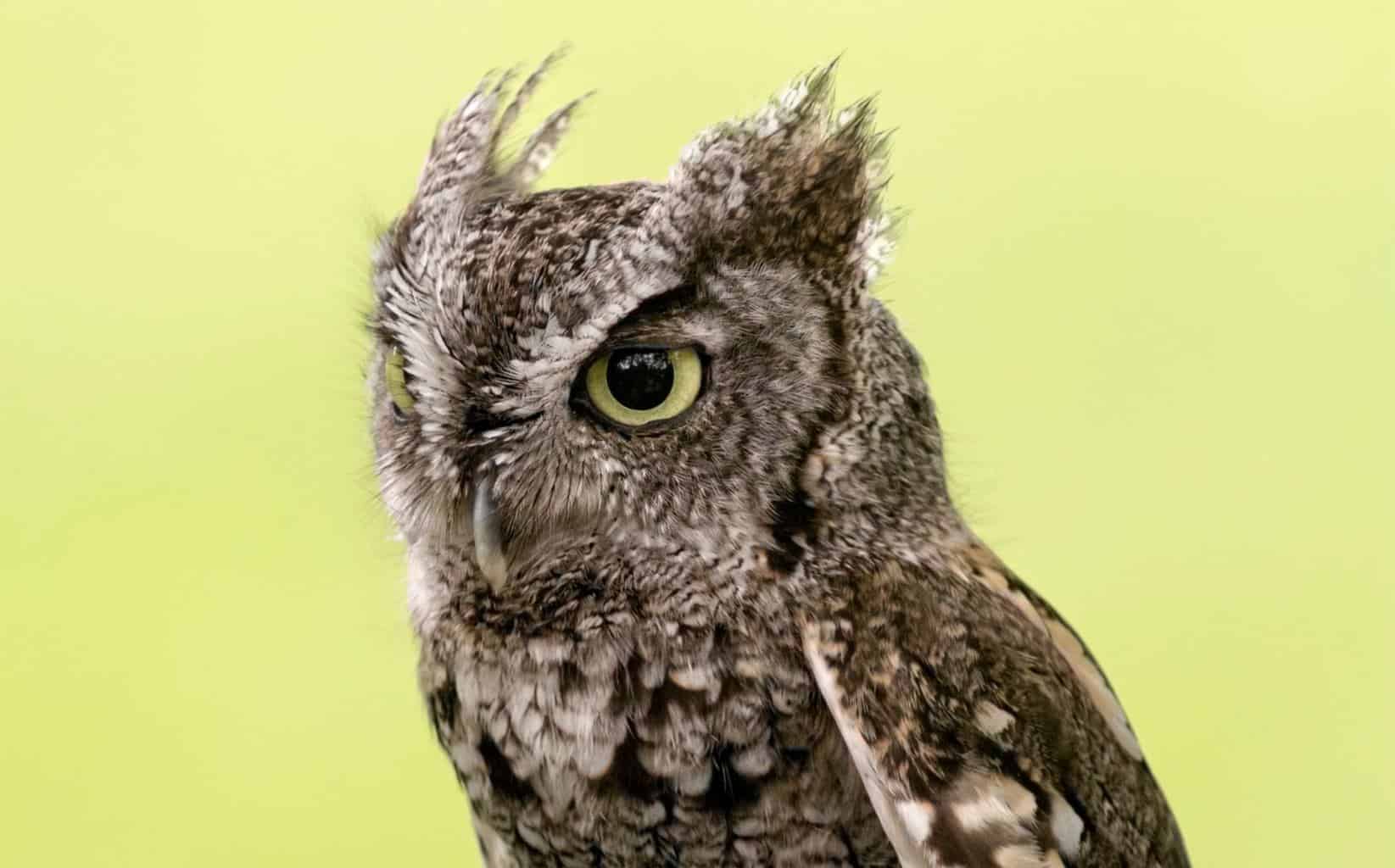
- Scientific Name: Megascops trichopsis
- Length: 6.5-8 inches
- Weight: 3 ounces (male), 3.3 ounces (female)
- Wingspan: 15.7-19.7 inches
The whiskered screech-owl can take a grey or red morph. It’s a well-proportioned bird, characterized by extra large yellow eyes and a distinct and melodious hoot.
Like most of the smaller-sized owls, this screech-owl’s diet consists mostly of large insects; throw in the occasional rodent if the prey is easy enough to catch. Note that these owls are quite territorial, and their domains could extend to a perimeter reaching 1,000 feet.
Western Screech-Owl

- Scientific Name: Megascops kennicottii
- Length: 7.5-9.8 inches
- Weight: 3.5-10.8 ounces
- Wingspan: 21.6-24.4 inches
The western screech-owl is small, but when it comes to its prey, it’s an open-minded bird that doesn’t think size matters all that much. This owl, not to be confused with its cousin, the eastern screech-owl, is known to hunt and prey on creatures bigger than itself, and at other times, it settles for rodents, bats, and even worms from compost heaps.
This screech-owl doesn’t really screech. Western screech-owl calls are a distinctive series of rhythmic hoots that are often described as a “bouncing ball pattern.”
The western screech-owls aren’t too particular about where they take residence, so the bird is just as comfortable in a tree as it is in a backyard.
Great Horned Owl
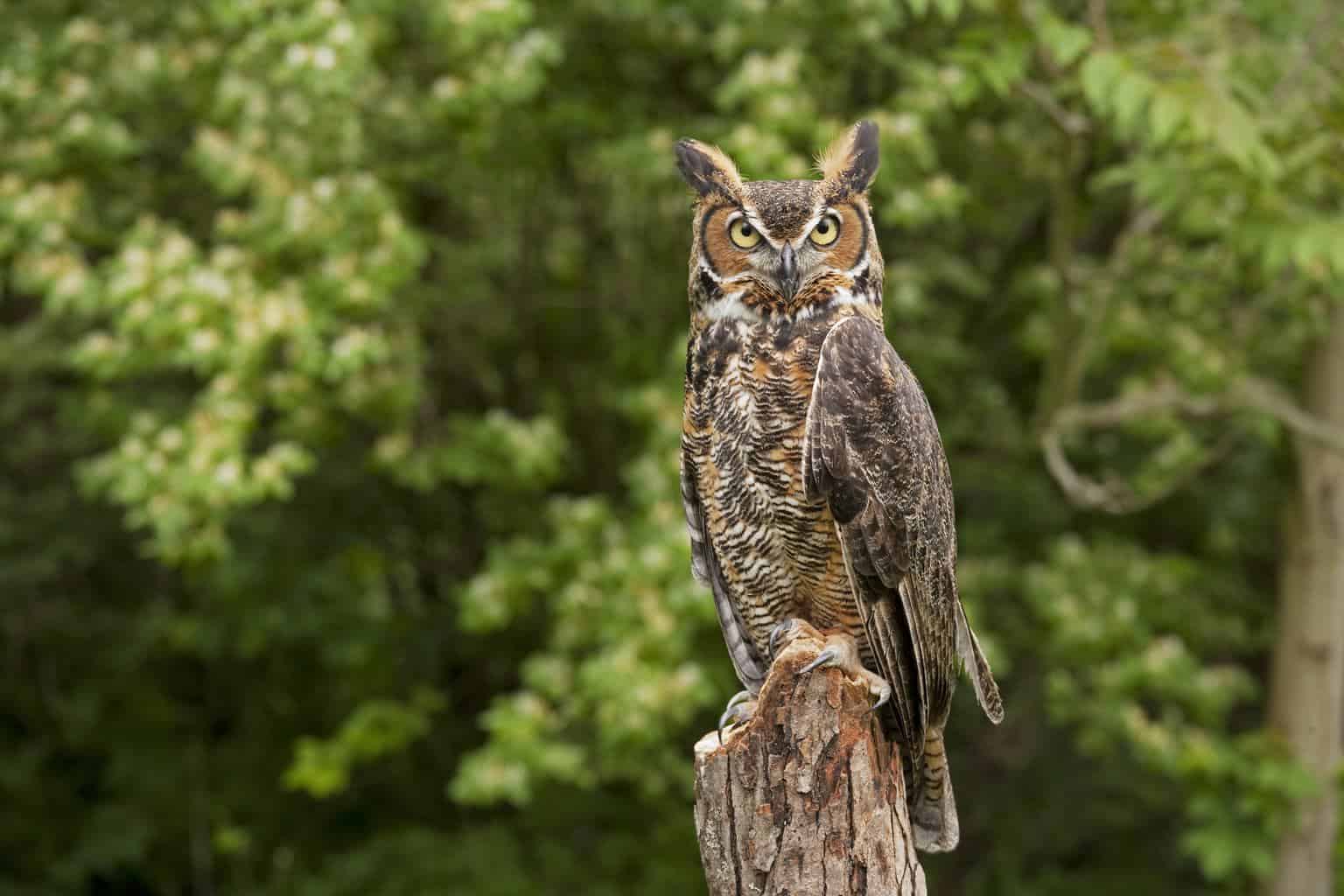
- Scientific Name: Bubo virginianus
- Length: 18.1-24.8 inches
- Weight: 32.1-88.2 ounces
- Wingspan: 39.8-57.1 inches
Great horned owls are quite massive; an adult of this species is only slightly smaller than a goose. So, if one of these owls is around, it won’t be hard to spot. Plus, they have large tufts of feathers on their ears and sage yellow eyes that make it easy to identify.
The great horned owl’s color varies depending on its geographical habitat. The ones around the Pacific are charcoal grey, southern owls are paler grey, and the Canadian varieties are almost snow white.
These owls are adaptable, so they can take residence almost anywhere. And the same goes for their favorite food; they’re quite content with any living creature, from prairie dogs to birds to rodents.
Northern Pygmy-Owl

- Scientific Name: Glaucidium gnoma
- Length: 6.3-7.1 inches
- Weight: 2.1-2.5 ounces
- Wingspan: 14.5-16 inches
As its name implies, the northern pygmy-owl is among the smaller-sized varieties of owls. The bird has a spherical head with no conspicuous ear tufts and yellow eyes that seem much too small for its face. It also sports a long narrow tail that’s not seen in many other species.
Northern pygmy-owls are diurnal predators, which makes them easier for you to spot while out on a birding expedition. They feed mainly on small birds, so there’s a good chance you’ll find them around backyard feeders.
Ferruginous Pygmy-Owl
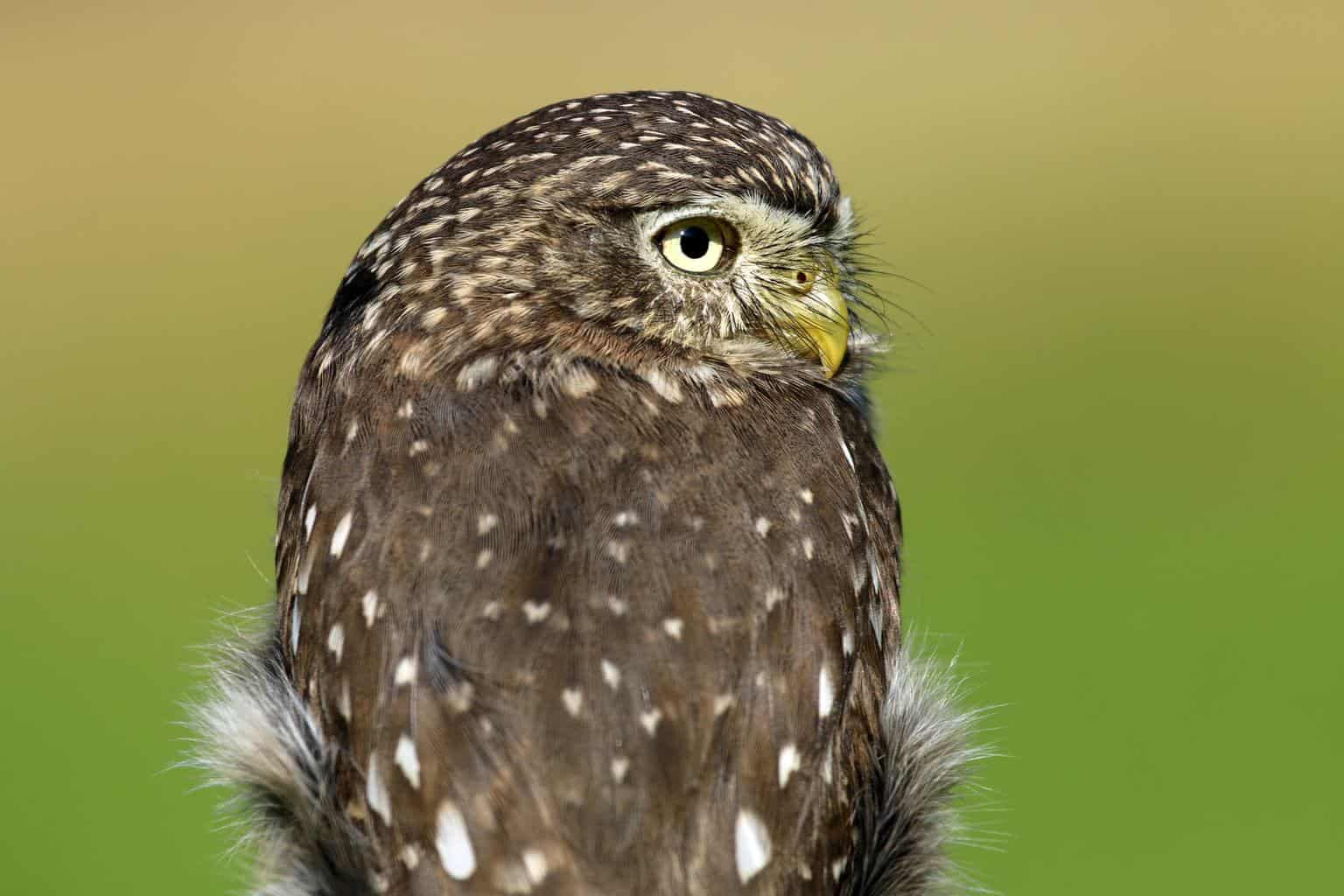
- Scientific Name: Glaucidium brasilianum
- Length: 5.1-5.5 inches
- Weight: 1.44 ounces
- Wingspan: 15.0 inches
The ferruginous pygmy-owl is a southern dweller that can be seen in Arizona, Texas, Mexico, and Central and South America. These miniature owls favor cactus deserts and wooded habitats that have open clearings.
The ferruginous pygmy-owl is a crepuscular and nocturnal predator that relies mostly on flying insects for food but will occasionally eat birds, mammals, and some reptiles.
Unfortunately, these owls are considered a threatened species in the United States, but they occur in higher numbers in the tropics. However, even there, they might be a bit difficult to spot.
Elf Owl
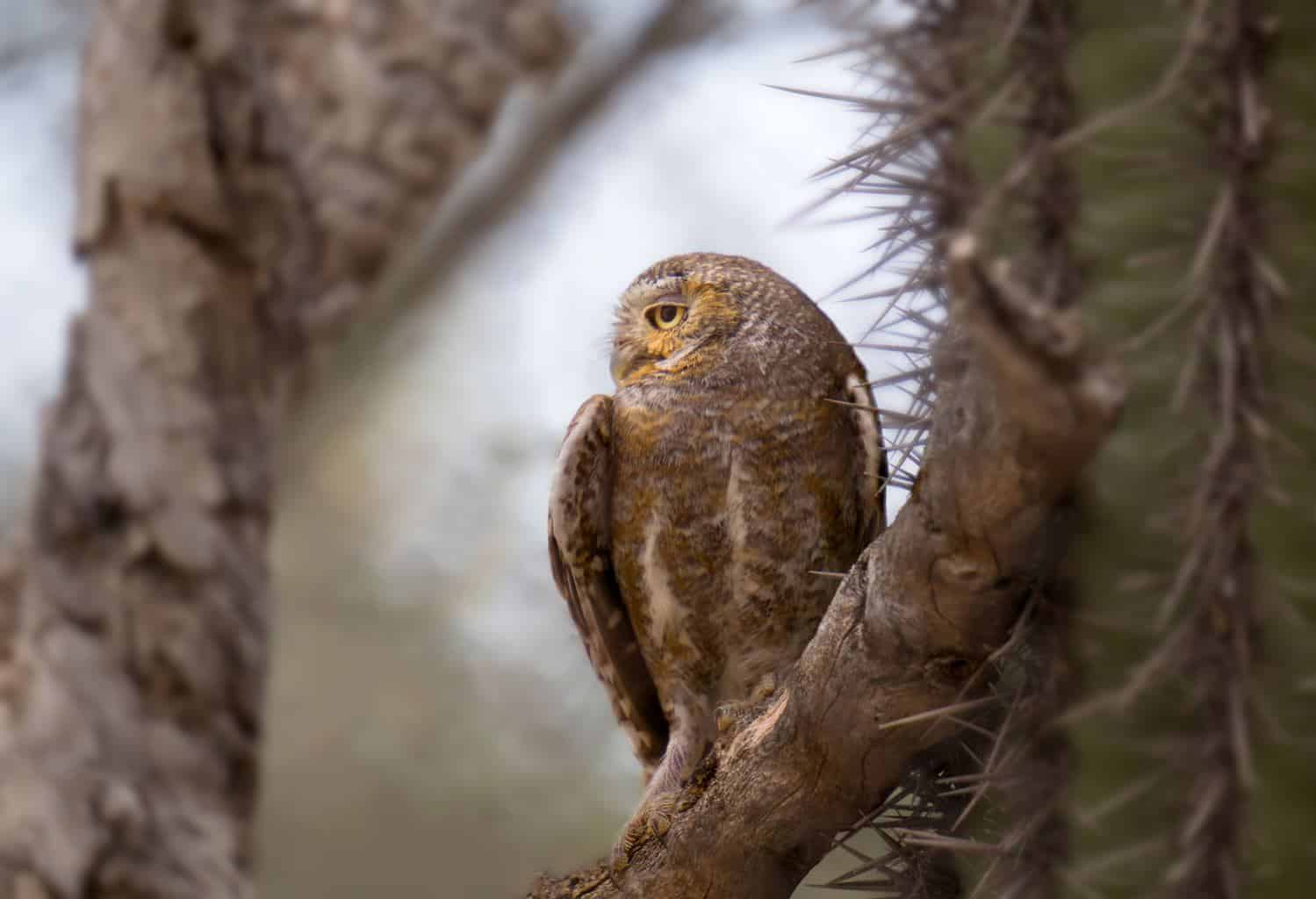
- Scientific Name: Micrathene whitneyi
- Length: 4.9-5.7 inches
- Weight: 1.4 ounces
- Wingspan: 10.5 inches
The elf owl is considered the world’s largest and smallest owl. It’s got a well-proportioned face with large and pale yellow eyes that are highlighted by a white halo. This owl stands on relatively long legs that seem to curve a little…pretty much like an elf.
The elf owl is part of Arizona’s year-round population, also living in various southwestern regions of the United States, and Central Mexico. They live like woodpeckers and even take up residence in their abandoned nests. The large cactus trees are rife with these owls, so they aren’t too hard to find.
Burrowing Owl

- Scientific Name: Athene cunicularia
- Length: 7.5-9.8 inches
- Weight: 5.3 ounces
- Wingspan: 21.6 inches
Burrowing owls are mostly light-brown with pale, mottled feathers on their underbellies. Their most prominent characteristics are their seemingly lidded eyes, white eyebrows, and slim, hooked bills. They’re roughly the size of a robin, and their heads are remarkably round.
As their name implies, these owls dig holes in the ground to live in, and if they find already-present holes dug by prairie dogs, tortoises, or ground squirrels, they’ll take them over in an instant. These day-hunters mainly feed on insects.
Burrowing owls aren’t too abundant currently, as their habitats were consistently disturbed by urbanization. This has also affected the numbers of prairie dogs and ground squirrels, which were indirect helpers of this owl species.
Spotted Owl
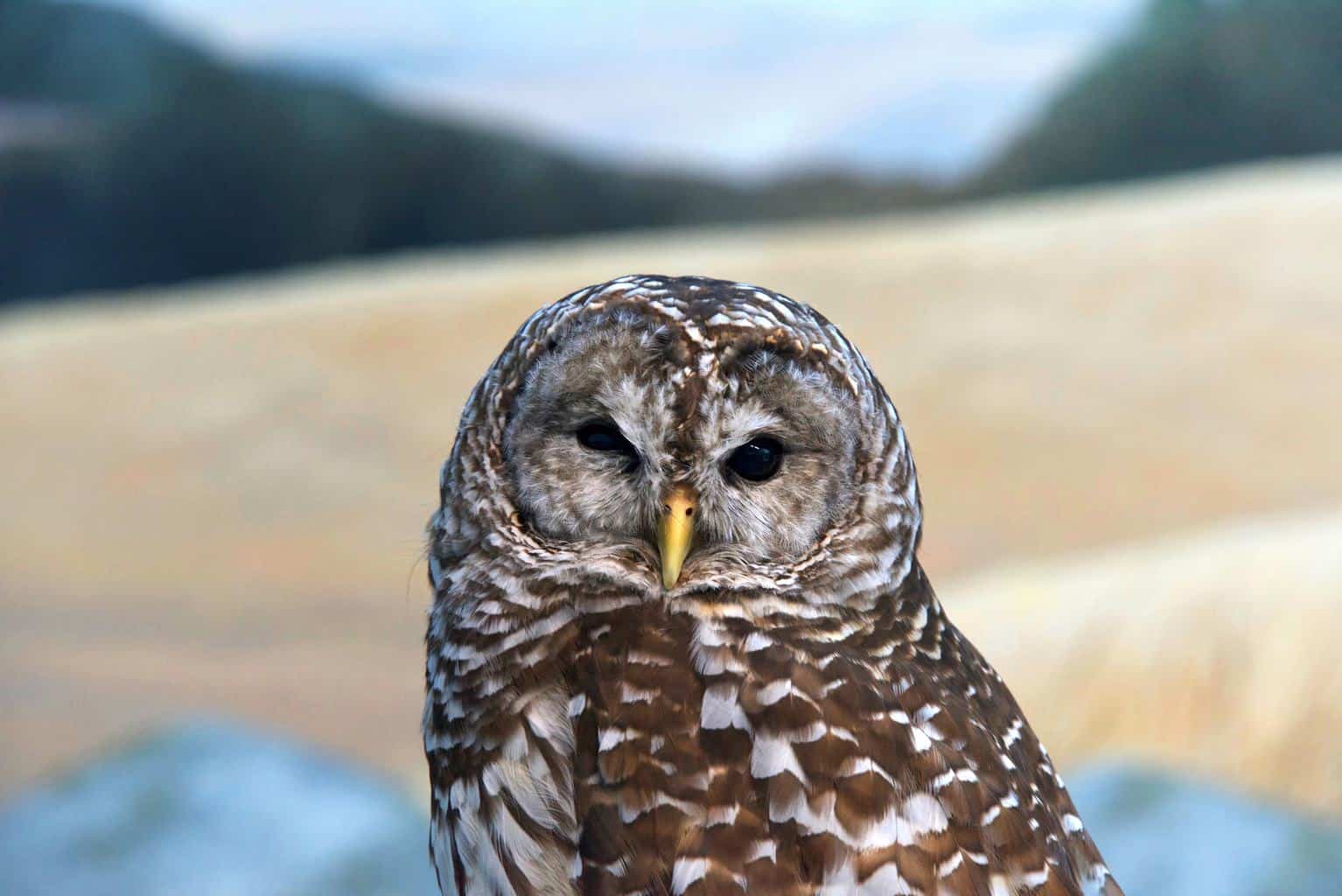
- Scientific Name: Strix occidentalis
- Length: 18.5-18.9 inches
- Weight: 17.6-24.7 ounces
- Wingspan: 39.8 inches
Spotted owls are among the larger species of owls, standing taller and heavier than a crow. These owls are mostly dark brown, and they have unmistakable faces; a white X-shape is drawn between their coal-colored eyes.
These owls spend their time inside trees and hunt mostly at night. They prefer to eat small mammals, like flying squirrels and woodrats. These patient nocturnal stalkers stay completely silent as they listen, and when they hear their prey, they swoop down quickly and snatch it up with their sharp talons.
Long-Eared Owl

- Scientific Name: Asio otus
- Length: 13.8-15.8 inches
- Weight: 7.8-15.3 ounces
- Wingspan: 35.4-39.4 inches
Long-eared owls are medium-sized birds with slim bodies and squarish faces. They also have prominent tufts of feathers (ear tufts) and pale orange facial disks. You’ll know this owl by its bright yellow eyes and surprised-looking expression.
These owls are tree-dwellers who hide well within the foliage. They don’t mind the company of their peers, so you just might find a large number of them in the same tree.
Long-eared owls are nocturnal predators who are adept precision hunters. They fly in complete silence and can easily find and catch prey in the absence of any light. And what’s on these nocturnal hunters’ menu? Its favorite foods are rodents and rabbits, plus an assortment of other small, ground-dwelling mammals.
Short-Eared Owl
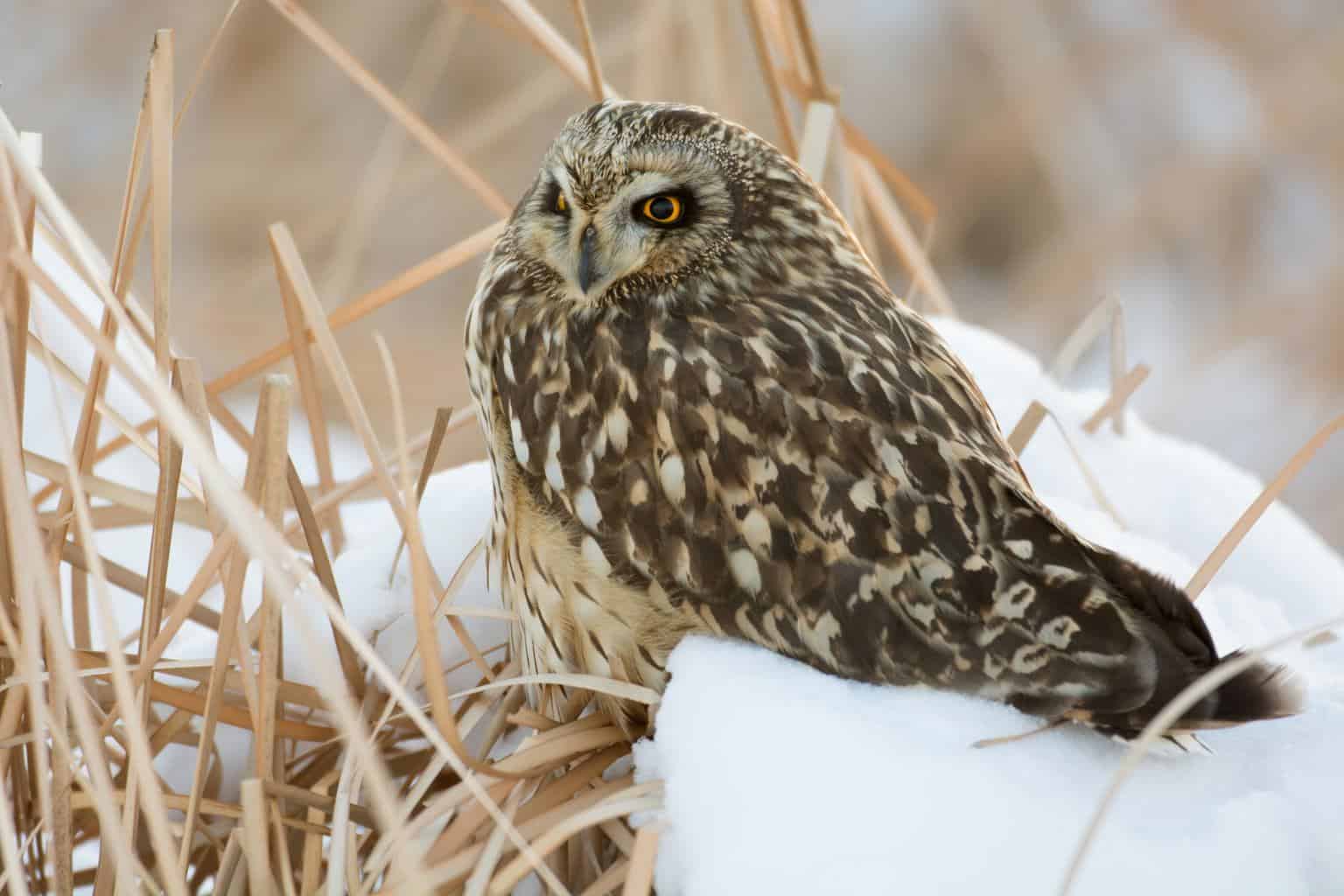
- Scientific Name: Asio flammeus
- Length: 13.4-16.9 inches
- Weight: 7.3-16.8 ounces
- Wingspan: 33.5-40.5 inches
Short-eared owls have broad wings, short tails, and smallish yellow eyes with dark markings around them. They’re approximately the size of a crow and live mostly in open areas or grasslands.
These birds of prey are daytime hunters who fly in a manner that’s quite similar to a moth. When it’s time to eat, you’ll find them feeding on rats, bats, birds, and other small vertebrates.
Northern Saw-Whet Owl
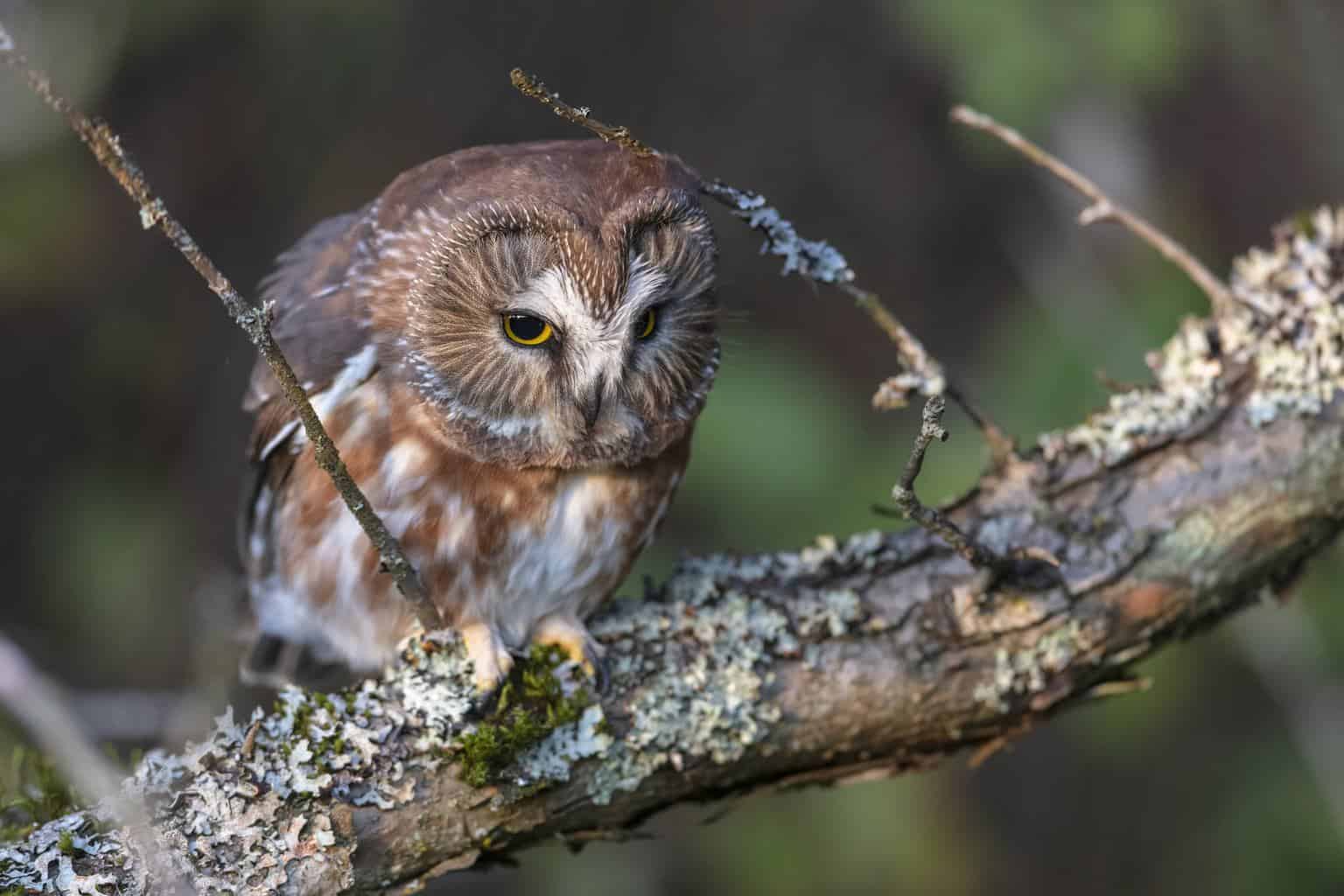
- Scientific Name: Aegolius acadicus
- Length: 7.1-8.3 inches
- Weight: 2.3-5.3 ounces
- Wingspan: 16.5-18.9 inches
Northern saw-whet owls are smallish birds with oversized heads. These owls, who are more abundant in the north but occasionally spotted in the south, have big and bright yellow eyes and cat-like faces.
They’re entirely nocturnal creatures who mostly feed on mice and other small vertebrates. A good way to detect these birds’ presence is by listening for their high-pitched calls.
In Conclusion
There are so many places to explore in Arizona and plenty of wildlife to see. The species of birds in the Grand Canyon State are as varied as its geography! And while you’re out and about looking for the wise and secretive owls, you might also want to check out the woodpeckers abundant in the Arizona wilderness.
Don’t stop your search here, though; North America is full of deserts and mixed forests for observing a wide range of animals, including our beloved bird friends.

